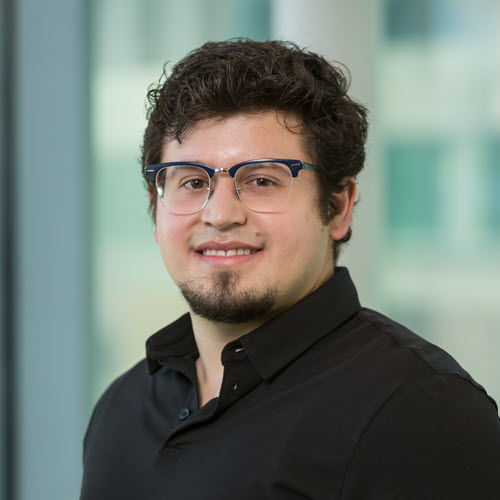Student Profile in Development and Evolution
Carlos G. Orozco
Mentor: Todd Roberts, Ph.D.
Undergraduate Degree: Biology & Neuroscience
Undergraduate Institution: University of Texas, Austin
Hometown: El Paso, TX
Awards/Fellowships: Graduate School: NINDS Individual Predoctoral Fellowship (F31) Neuroscience Scholars Program Fellowship SACNAS Travel Award Nominated, HHMI Gilliam Fellowships for Advanced Study Honorable Mention, Ford Foundation Fellowship NIH Diversity Supplement Funding Undergraduate School: University & CNS Honors Wally Scott Endowed Scholarship Jennie and Carl Sundberg Scholarship TG’s Charley Wootan Scholarship
How did you become interested in science and/or research?
My interest in science began during my high school IB Biology course, where I learned about emergent properties. Emergent properties are instances where smaller parts combine to gain characteristics that are irreducible, such as macromolecules forming cells. The emergent property that captivated me the most was consciousness – the way that electrochemical signaling across networks of neurons results in self-awareness. The idea that cells could use electrochemical signaling to create our complex cognitive functions seemed impossible to me, and I was determined to learn more about how these cells worked together and how these complex networks emerged. Then during my postbaccalaureate program, I became immersed in an environment where these complex neurological systems were constantly being explored and discussed, leading to more questions and furthering my curiosity. This experience convinced me that I wanted to continue working in this field and hopefully contribute to our understanding of these complex systems.
Please describe your research.
Vocal learning, the ability to imitate and/or modify vocalizations, is a crucial aspect of spoken language and is only found in a few animal species, such as songbirds. However, there are significant differences in overall brain anatomy between songbirds and humans. Since cells are the fundamental building blocks of all living organisms, and neurons are the building blocks of the brain and cognition, my research aims to use single-cell transcriptomics to investigate whether similar and rare behaviors may be fundamentally similar at the cellular level.
Why did you choose UT Southwestern?
I was initially drawn to UTSW and its Neuroscience program because of its impressive research in both translational and basic sciences, covering a wide range of topics from autism spectrum disorder to the evolution of the brain. I was further impressed by the umbrella program that would provide me with a strong foundation in both neuroscience and general biological concepts. I was also excited about the opportunity to rotate in different labs, which would help me become a more well-rounded scientist and potentially lead to future collaborations. The deciding factor for me, however, was during interview weekend when I saw the collaborative and welcoming environment at UTSW. I was convinced that both the faculty and fellow graduate students are invested in the success of all graduate students, and I knew that this was the right program for me.
In your opinion, what makes the Neuroscience Graduate Program one of the top in the country?
UTSW is a leading institution in the field of translational and basic science research. Its pioneering research constantly answers fundamental questions in neuroscience using state-of-the-art techniques such as single-cell transcriptomics, optogenetics, and in vivo electrophysiological recordings. The numerous cores and shared facilities allow students to receive expert training in many of these techniques, such as the bioinformatics and next generation sequencing core. Furthermore, UTSW's rigorous umbrella program provides a strong foundation for understanding biological sciences. It trains students to become effective and independent scientists through grant writing training, experimental design exercises, and journal clubs on topics such as epigenetics and computational analysis. There are also many student organizations that focus on areas such as diversity, career development, and outreach. These organizations receive support from the Office of Student Empowerment and Engagement or other mechanisms to fund outreach, professional development, and other goals set by the organization. Overall, UTSW has a supportive and innovative environment that is constantly improving to train students to become successful scientists.
What do you love about the Neuroscience Graduate Program?
The program not only conducts cutting-edge research, but also fosters a collaborative and inclusive environment. Inter-lab collaboration is frequent, leading to more comprehensive and innovative projects. For instance, the close collaboration between Dr. Konopka and Dr. Roberts has allowed me to benefit from the combined expertise of both labs and conduct thorough research on the evolution of the brain and vocal learning. Moreover, the students and faculty in the program are constantly working to improve the program and create a more inclusive environment. For example, the Neuroscience Diversity and Inclusion group collaborates with student diversity organizations such as SACNAS, oSTEM, and TAAAS to provide support and resources to underrepresented students. Thanks to this supportive and inclusive environment, I have been able to succeed in this demanding program.
– Carlos G. Orozco, Neuroscience Graduate Program

